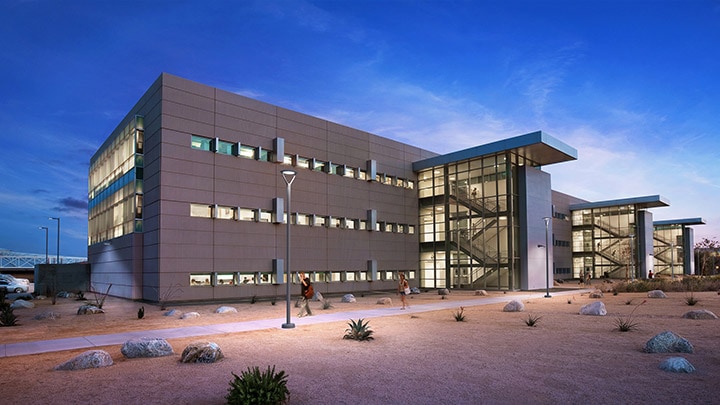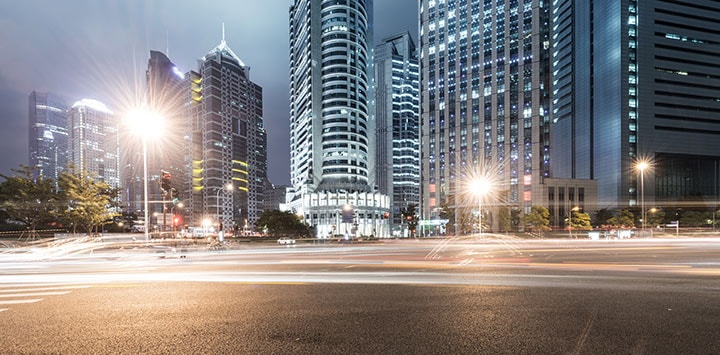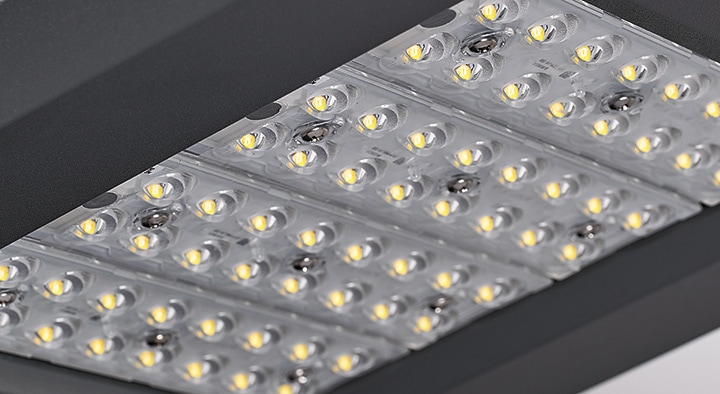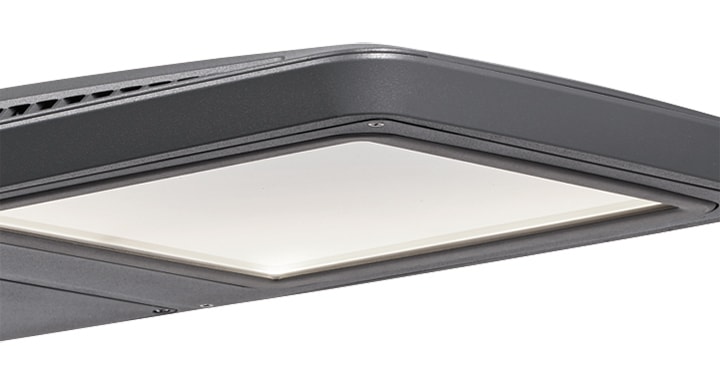

LED Source Size and Technologies
A common perception is that LED products contribute more to discomfort glare than HID products. In many cases, customers who have replaced HID products with LEDs have more complaints about glare than prior to the switch. There are a couple reasons why this the case. The most common reason for this phenomenon is pixilation of the light source. LEDs are small in size, but tend to deliver very high intensities, so the luminance (defined as the luminous intensity per unit area) is quite high compared to that of an HID lamp. While the HID lamp luminous flux comes directly from a small arc tube, it is worth noting that the reflectors used on the HID products contribute to a greater luminous opening.
With LEDs, most products do not use reflectors. The common optics used to control LED light are delivered primarily through direct view in very small areas. These areas themselves are distinctive enough to create a non-uniform luminance contrast between each LED, which is one of the factors contributing to discomfort glare. To keep product costs down, luminaire designers have been reducing the number of LEDs, but increasing the intensity, which tends to worsen the situation.

This has become such a problem with LEDs that manufacturers have developed techniques to reduce this effect. The simplest and most common method is to add a diffuse lens to the luminaire. To some degree, this softens pixilation, but does so at the expense of optical distribution and efficacy. This happens because the diffuser randomly scatters the light, which limits the control. It also impacts the efficacy, because the diffuser simply changes the direction of the light beam. As a result, some light is lost through refraction, absorption in the diffuser, or reflection back into the luminaire. Another technique for minimizing LED glare is to reduce the space between LEDs (known as pitch). However, this has other challenges in optical design because if the LEDs are too close to each other, there is limited space left and thus limited design freedom.
A better method for minimizing LED glare is using a light guide lens that is edge lit. This technology -borrowed from LED TV displays - consists of LEDs located at the edge of a light guide plate and the light is piped through this plate by means of internal reflection. Microstructures present on outside surface of the lens are used to extract and control the light distribution. The extraction and control of the light on these light guide plates are not yet at the performance levels of the direct view optic method, but the technology is improving.

Luminaire Glare Metrics
While there have been many different models created to categorize glare as a metric, none do a good job in making it universal. Therefore, none of these models are useful as a comparative metric between luminaire specifications. The most popular metric is the unified glare rating (UGR), which is used mainly for interiors.3 For outdoor applications, glare concepts like the "threshold increment IT" and "glare control mark G" have been developed primarily for road lighting for motorized traffic. Reference4 formulates the GR rating as a function of the vailing luminance produced by both the luminaires and the environment. As with other methods, there is still difficulty in establishing parameters to specify the luminaire, due to interdependency with the environment and the observer's position and viewing direction with respect to the glare source.
The most commonly used method to measure glare for outdoor lighting is the G rating, a system on the BUG rating scale (based on IES TM-155). In this metric, there is a scale for the glare rating, which is based on an absolute value in lumens depending on the zonal lumens of the distribution. For luminaire comparison, you could use this metric to extract the environmental factors that are independent of the luminaire. Note however, this metric is incomplete and not always ideal - for few reasons. First, the G rating value is based on luminous flux, and not true luminaire luminance. Second, it does not consider the other factors affecting glare directly, like luminaire uniformity and size of luminance opening.
While lighting technology has evolved to solve many issues as it pertains to glare, the standards and metrics to help designers specify luminaires have not. Existing standards have many drawbacks, so it is challenging to specify a luminaire without resorting to expensive and time-consuming mock-ups. More research will need to happen in this area, so that luminaire manufacturers can adopt a glare metric that is consistent across the industry.
1 Illuminating Engineering Society. ANSI/IES RP-8-18 Recommended Practice For Design and Maintenance of Roadway and Parking Facility Lighting, 2018.
2 P. Petherbridge, R. G. Hopkinson, “Discomfort Glare and the Lighting of Buildings”, Published February 1, 1950
3 “The Elusive Discomfort Glare Metric”, Naomi J Miller, FIES, Pacific Northwest National Laboratory https://www.ies.org/fires/the-elusive-discomfort-glare-metric
4 International Commission on Illumination, CIE 112-1994 Glare Evaluation System for Use within Outdoor Sports and Area Lighting, 1994
5 Illuminating Engineering Society. IES TM-15-11 Luminaire Classification System For Outdoor Luminaires, Addendum A.

November 14, 2023
How lighting technology can help reduce risks to migrating birds